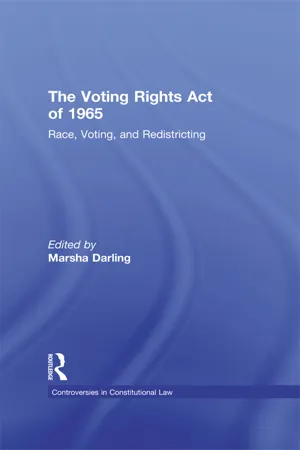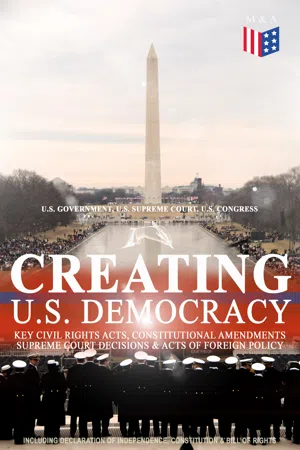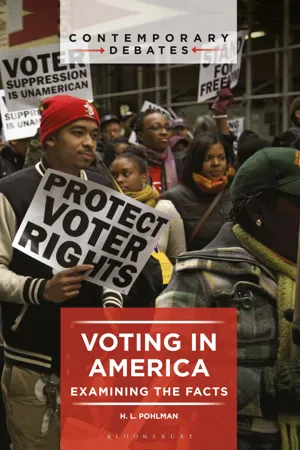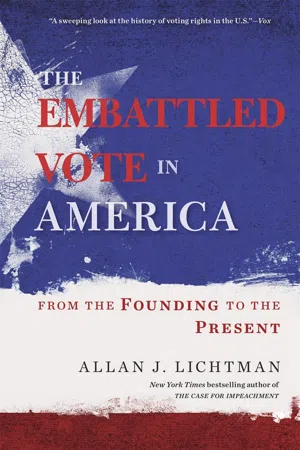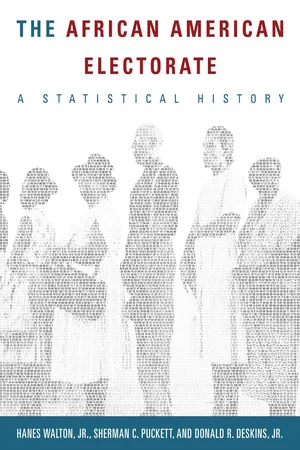History
Voting Right Act of 1965
The Voting Rights Act of 1965 was a landmark piece of legislation in the United States that aimed to overcome legal barriers at the state and local levels that prevented African Americans from exercising their right to vote. It prohibited discriminatory voting practices, such as literacy tests and poll taxes, and provided federal oversight of elections in areas with a history of voter suppression. The Act played a crucial role in advancing civil rights and political participation for African Americans.
Written by Perlego with AI-assistance
Related key terms
1 of 5
10 Key excerpts on "Voting Right Act of 1965"
- eBook - ePub
The Voting Rights Act of 1965
Race, Voting, and Redistricting
- Marsha Darling(Author)
- 2013(Publication Date)
- Routledge(Publisher)
THE VOTING RIGHTS ACT OF 1965 AUGUST 6, 1965Be it enacted by the Senate and House of Representatives of the United States of America in Congress assembled, That this Act shall be known as the “Voting Rights Act of 1965”.SEC . 2. No voting qualification or prerequisite to voting, or standard, practice, or procedure shall be imposed or applied by any State or political subdivision to deny or abridge the right of any citizen of the United States to vote on account of race or color.SEC . 3. (a) Whenever the Attorney General institutes a proceeding under any statute to enforce the guarantees of the fifteenth amendment in any State or political subdivision the court shall authorize the appointment of Federal examiners by the United States Civil Service Commission in accordance with section 6 - Martha E. Kropf(Author)
- 2016(Publication Date)
- Palgrave Macmillan(Publisher)
14 Indeed, Section 5 of the Voting Rights Act was a new approach to the racial discrimi- nation in voting that would, as articulated by Justice Ruth Bader Ginsberg in her dissent to the Shelby v. Holder finding, resemble “battling the Hydra.” However, as noted in Chapter 4, the Supreme Court struck down the formula that defined which jurisdictions were subject to Section 5 in June 2013. In early 2015, citizens remembered the 1965 Selma march, which was a triggering event for the passage of the Voting Rights Act. CBS Television anchor Bob Schieffer interviewed Congressman John Lewis (D-GA), who helped plan the march from Selma to Montgomery. When the marchers crossed the Edmund Pettus Bridge, they were confronted by state troop- ers and sheriffs who came toward them, beating them with night sticks, using tear gas and trampling them with horses. Lewis, who was in the front, was the first person to be hit. 15 In news coverage of a reenactment of the march, a CBS News Poll asked Americans if the Voting Rights Act is necessary today. Interestingly, a majority of Americans say yes, but there is a deep racial divide, with 86 percent of African Americans saying it is necessary and only 55 percent of Caucasians. 16 The poll showed that nearly two- thirds of Americans say they do not have enough information to evaluate whether or not the Supreme Court should have overturned Section 5. 17 Finally, of the people who answered the poll, 12 percent of African Americans reported they had trouble voting; only 7 percent of White Americans had trouble. 18 Immigrant Voting As noted in the first chapter of this book, most Americans today believe that voting is a basic duty of a citizen. Given the current political climate, this also means that 74 I n s t i t u t i o n s a n d t h e R i g h t t o V o t e i n A m e r i c a noncitizens are explicitly barred from voting. In an article entitled “The Threat of Non-Citizen Voting,” Heritage Foundation scholar Hans A.- eBook - ePub
Forging U.S. Democracy
The Influence of Key Civil Rights Acts, Amendments, and Landmark Decisions
- U.S. Government, U.S. Supreme Court, U.S. Congress(Authors)
- 2017(Publication Date)
- Madison & Adams Press(Publisher)
Voting Rights Act
(1965)Table of ContentsThe first page of the Voting Rights Act.Passage contains an image
The last page of the Voting Rights Act.Passage contains an image
Eighty-ninth Congress of the United States of America At the First Session Begun and held at the city of Washington, on Monday, the fourth day of December, one thousand nine hundred and sixty-fiveAN ACT To enforce the fifteenth amendment to the Constitution of the United States, and for other purposes. Be it enacted by the Senate and House of Representatives of the United States of America in Congress assembled, That this Act shall be known as the "Voting Rights Act of 1965".Sec. 2.No voting qualification or prerequisite to voting, or standard, practice, or procedure shall be imposed or applied by any State or political subdivision to deny or abridge the right of any citizen of the United States to vote on account of race or color.Sec. 3. - eBook - ePub
Voting in America
Examining the Facts
- H. L. Pohlman(Author)
- 2020(Publication Date)
- ABC-CLIO(Publisher)
3The Voting Rights Act in the Twenty-First Century
As discussed in chapter 1 , the original Constitution delegated the authority to decide who can vote in federal elections to state legislatures, reserving for Congress the power to alter the “Regulations” states imposed on the “Times, Places, and Manner” of federal elections. Of course, important amendments to the Constitution have restricted state control over the federal right to vote by prohibiting any denial or abridgment of the right on grounds of race, sex, age, or ability to pay a tax. These amendments, however, were negative rather than positive in form. By telling states what they cannot do regarding the right to vote, not what they must do, the Constitution established a constitutional floor—a minimal set of requirements that state governments must respect. In contrast, the Voting Rights Act of 1965 (VRA) extended and broadened the American right to vote in a positive sense beyond the constitutional minimum. In doing so, the significance of the VRA is monumental. Many commentators have argued that the VRA is the most effective civil rights law Congress has ever enacted.The VRA is also important because it granted the executive branch of the federal government the authority to enforce the expanded right to vote. Such federal enforcement of statutory voting rights can, in some ways, be far more effective than judicial decisions protecting the right to vote in individual lawsuits. Whereas executive enforcement can be applied across jurisdictions, a lawsuit is typically reactive to a specific wrong and limited to the specific circumstances of a particular case within a single jurisdiction. Moreover, the VRA authorized the federal government to require states to take positive steps to empower voters and prevent states from violating the right to vote, whether the right was rooted in the Constitution or in the VRA. Lastly, the VRA gave courts another foundation, other than the Constitution, on which to base their decisions regarding the right to vote. Of course, courts might interpret a provision of the VRA in a narrow way, but if so, then Congress could amend the law, pushing courts to expand the statutory right to vote. For the above reasons, the passage of the VRA set the stage for a transformation of the American right to vote, making it more meaningful and robust for millions of American citizens. However, in Shelby County v. Holder (2013), the Supreme Court invalidated a crucial provision of the VRA that enabled the federal government to protect the right to vote from state infringements (see Q23 - eBook - ePub
Ballot Blocked
The Political Erosion of the Voting Rights Act
- Jesse H. Rhodes(Author)
- 2017(Publication Date)
- Stanford University Press(Publisher)
“The Voting Rights Act was aimed at the subtle, as well as the obvious, state regulations which have the effect of denying citizens their right to vote because of their race,” the majority pronounced. “Moreover, compatible with the decisions of this Court, the Act gives a broad interpretation to the right to vote, recognizing that voting includes ‘all action necessary to make a vote effective ’” (the internal quotation comes directly from the statute, with emphasis added). 147 By interpreting the phrase “make a vote effective” broadly to mean “make a vote capable of exercising substantive political power” rather than simply “make a vote legally valid,” an understanding grounded in the Court’s recent reapportionment decisions, the majority established a jurisprudential rationale for reading the statute to require Section 5 coverage of rules not pertaining directly to the process of voting. 148 But the majority opinion also relied heavily on the historical claim that “in passing the Voting Rights Act, Congress intended that state enactments such as those involved in the instant cases be subject to the Section 5 approval requirements” (emphasis added). 149 The bulk of the opinion was a defense of this construction of congressional intent - eBook - ePub
American Constitutional Law, Volume II
The Bill of Rights and Subsequent Amendments
- Ralph Rossum, G. Alan Tarr, Vincent Phillip Munoz(Authors)
- 2019(Publication Date)
- Routledge(Publisher)
Petitioner Shelby County, in the covered jurisdiction of Alabama, sued the Attorney General in Federal District Court in Washington, D.C., seeking a declaratory judgment that Sections 4 and 5 are facially unconstitutional as well as a permanent injunction against their enforcement. The District Court upheld the Act, finding that the evidence before Congress in 2006 was sufficient to justify reauthorizing Section 5 and continuing Section 4’s coverage formula. The D.C. Circuit affirmed. After surveying the evidence in the record, that court accepted Congress’s conclusion that Section 2 litigation remained inadequate in the covered jurisdictions to protect the rights of minority voters, that Section 5 was therefore still necessary, and that the coverage formula of Section 4 continued to pass constitutional muster. The Supreme Court granted certiorari. Opinion of the Court: Roberts , Scalia, Kennedy, Thomas, Alito. Concurring opinion: Thomas . Dissenting opinion: Ginsburg , Breyer, Sotomayor, Kagan.CHIEF JUSTICE ROBERTS delivered the opinion of the Court.The Voting Rights Act of 1965 employed extraordinary measures to address an extraordinary problem. Section 5 of the Act required States to obtain federal permission before enacting any law related to voting – a drastic departure from basic principles of federalism. And Section 4 of the Act applied that requirement only to some States – an equally dramatic departure from the principle that all States enjoy equal sovereignty. This was strong medicine, but Congress determined it was needed to address entrenched racial discrimination in voting, “an insidious and pervasive evil which had been perpetuated in certain parts of our country through unremitting and ingenious defiance of the Constitution.” South Carolina v. Katzenbach (1966). As we explained in upholding the law, “exceptional conditions can justify legislative measures not otherwise appropriate.” Reflecting the unprecedented nature of these measures, they were scheduled to expire after five years.Nearly 50 years later, they are still in effect; indeed, they have been made more stringent, and are now scheduled to last until 2031. There is no denying, however, that the conditions that originally justified these measures no longer characterize voting in the covered jurisdictions. By 2009, “the racial gap in voter registration and turnout [was] lower in the States originally covered by §5 than it [was] nationwide.” Since that time, Census Bureau data indicate that African-American voter turnout has come to exceed white voter turnout in five of the six States originally covered by §5, with a gap in the sixth State of less than one half of one percent.At the same time, voting discrimination still exists; no one doubts that. The question is whether the Act’s extraordinary measures, including its disparate treatment of the States, continue to satisfy constitutional requirements. As we put it a short time ago, “the Act imposes current burdens and must be justified by current needs.” - eBook - PDF
The Embattled Vote in America
From the Founding to the Present
- Allan J. Lichtman(Author)
- 2018(Publication Date)
- Harvard University Press(Publisher)
158 THE EMBATTLED VOTE IN AMERICA Amendments. The successful bill was the first national voting rights legislation since Reconstruction, and even in its watered- down version had important implications for black suffrage. It es-tablished the Civil Rights Division of the U.S. Department of Justice and the independent U.S. Commission on Civil Rights, and it autho-rized the Justice Department to initiate civil suits to prevent in-fringements of the right to vote. 21 During the Eisenhower years, the Civil Rights Division cautiously enforced the act, filing fewer than ten voting rights lawsuits. Enforce-ment stepped up during the Kennedy administration, aided by amendments passed in 1960 that made for easier enforcement of the 1957 act. Although John F. Kennedy’s Civil Rights Division filed more than fifty voting rights suits, this case-by-case approach did not put much of a dent in the disenfranchisement of black people in the Deep South. In Mississippi, Alabama, Georgia, and Louisiana (where more than 90 percent of the litigation had taken place), black regis-tration rates on average increased by only 2.6 percentage points from 1956 to 1964. Litigation was costly and slow. The average elapsed time between the filing of a complaint and the beginning of trial was 16.3 months. An average of 17.8 months elapsed between the commence-ment of trial and the entry of judgment. Appeals from an adverse decision took approximately one year, and in most cases either the government or the defendant appealed. Lawsuits faced resis-tance from frequently hostile southern judges, and the discretion vested in the local registrar made it difficult to end discrimina-tion even after winning judicial relief. The Roman sage Cicero fa-mously said, “The foundation of justice is good faith.” Of that, there was precious little among the white Democrats who controlled southern governments. - eBook - PDF
The History and Politics of Voting Technology
In Quest of Integrity and Public Confidence
- R. Saltman(Author)
- 2006(Publication Date)
- Palgrave Macmillan(Publisher)
5 T he M iddle and L ate T wentieth C entury: M ovements for E quality, E nfranchisement, and V oting F acilitation 5.1 The E ffort to End Racial Discrimination It is not possible in this presentation to graphically detail the events of the 1950s and 1960s that led to the passage of the Civil Rights Act of 1964 (Public Law 88-352, July 2, 1964) and the Voting Rights Act of 1965 (Public Law 89-110, August 6, 1965). The high level of public emotion can be cited, but not explicitly described with the literary flavor that it deserves. An initiating factor was the heightened demand on the part of the black com- munity of the South that their second-class citizenship be brought to an end. The sympathetic response by many whites throughout the nation, except in the South, made it possible. The problem of African Americans in the South was not only their inability to vote; it was the pervasive segregation that resulted in inferior treatment in almost every aspect of life. Despite the Supreme Court ruling in Brown v. Board of Education of Topeka in 1954 that school segregation was inherently unequal, little had changed in the years immediately afterward. The Birmingham, Alabama, bus boycott, triggered by Rosa Parks’s refusal to give up her seat to a white man, had occurred in 1955. The following years were filled with demonstrations—“sit-ins” that attempted to desegregate restaurants and restrooms, demands for “try-on” privileges in clothing stores, and violent reactions by some whites. Some blacks who had attempted to register to vote were summarily dismissed, oth- ers were shot down, and little was done by local white authorities to pursue justice. While the Civil Rights and Voting Rights Acts were intended to end the unconscionable discrimination against African Americans, the elimination of voting restrictions due to race would apply also to American Indians, Alaskan Natives, and Asian Americans. - eBook - ePub
Taking the Fight South
Chronicle of a Jew's Battle for Civil Rights in Mississippi
- Howard Ball(Author)
- 2021(Publication Date)
- University of Notre Dame Press(Publisher)
The act suspended all literacy tests and other devices used to determine whether a person could vote. These literacy tests had existed for six or more decades and effectively restricted Black voters in the South from registering to vote. The act’s passage in 1965 both affirmed the basic principles of a democratic society and stated the objectives the federal government had to pursue in order to end racially discriminatory voting practices in the nation, especially the restrictions very successfully used in the more than a dozen Southern states.Sections 4 and 5 of the new legislation would, it was hoped, effectively provide a federal check on all changes in a community’s voting practices (e.g., a change from a single member district to an at-large district or a change of voting venue), requiring that any change be approved by the federal government before being permitted. Each proposed voting change was allowed if it did not have the intent or the purpose of discriminating against Black voters. Under these provisions, a state or local jurisdiction would be permitted to change voting patterns only if the US District Court in Washington, DC, was convinced that the proposed change would not dilute Black voting strength. During committee discussions about the bill, the legislators had agreed to add the US Department of Justice as a second-choice reviewer of proposed voting changes reported to the federal government. It was noted that the federal trial court judges would be swamped with requests for approval, or “preclearance,” of proposed changes, leading to a backlog of preclearance requests and thus intolerable delays in the federal government’s answering of the requests. Legislators also thought that the DOJ was a less expensive and less onerous method of obtaining federal approval of a proposed voting change. In the end, the act created a joint administration of section 5. - eBook - PDF
The African American Electorate
A Statistical History
- Hanes Walton, Sherman C. Puckett, Donald R. Deskins(Authors)
- 2012(Publication Date)
- CQ Press(Publisher)
Thus, whether one is talking about the Four Military Reconstruction Acts, the Fifteenth and Nineteenth Amendments, or the VRA and its renewals, these all intended to resolve African American electoral problems. And if one is not careful, to focus simply on any one of these laws is to put on blinders because such a focus cannot provide a holistic portrait of the central reality, the suf-frage struggle of the African American electorate in America. This is not to say that one cannot combine these three major literatures but to treat remedies and reforms as the centerpiece is an error and treats the symptom as the problem. The problem is systemic; not the remedy. When this type of conceptualization occurs (and it has, as we shall see), then clarity is replaced by misdirection. Classifying the Voting Rights Act Literature Our initial category of VRA literature is “Suffrage Rights and the Voting Rights Act.” This contains three books that combine the suffrage rights struggle with descriptive and evaluative criti-cism on the Voting Rights Act as public policy, which addresses problems faced by the African American electorate. The one exception here is Professor Garth Pauley’s LBJ’s American Promise: The 1965 Voting Rights Address, which covers the suf-frage rights struggle but focuses on how President Lyndon B. Johnson shaped and used his voting rights address to convince the nation to support this national policy. On the other hand, Professor Garrow’s book basically begins its story and analysis with the 1940s and ends it with President Ronald Reagan sign-ing the 1982 renewal in a White House Rose Garden ceremony. The book by Professor Richard Valelly starts with President Lincoln speaking from the White House balcony about which group of freedmen should get suffrage rights on April 11, 1865, and concludes with the 1992 Language Assistance Amendments, which called for bilingual ballots.
Index pages curate the most relevant extracts from our library of academic textbooks. They’ve been created using an in-house natural language model (NLM), each adding context and meaning to key research topics.
